Chapter: 11th 12th std standard Class Physics sciense Higher secondary school College Notes
Horizontal and Vertical oscillations of spring
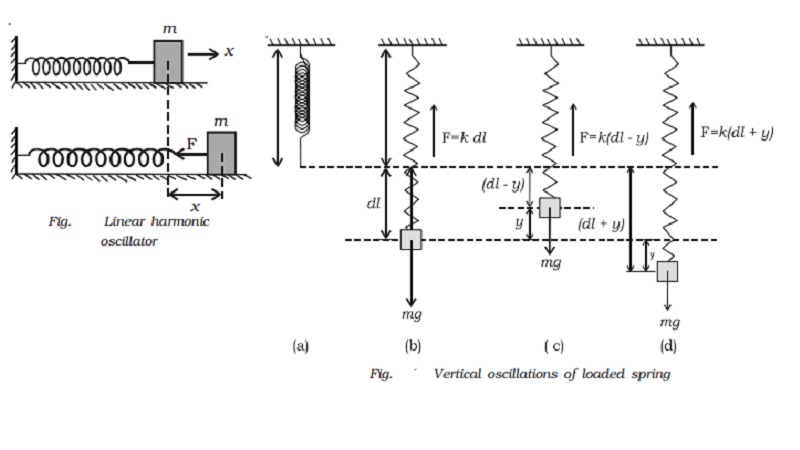
Linear
simple harmonic oscillator
The block − spring system is a linear
simple harmonic oscillator. All oscillating systems like diving board, violin
string have some element of springiness, k (spring constant) and some element
of inertia, m.
Horizontal
oscillations of spring
Consider a mass (m) attached to an end
of a spiral spring (which obeys Hooke?s law) whose other end is fixed to a
support as shown in Fig.. The body is placed on a smooth horizontal surface.
Let the body be displaced through a distance x towards right and released. It
will oscillate about its mean position. The restoring force acts in the
opposite direction and is proportional to the displacement.
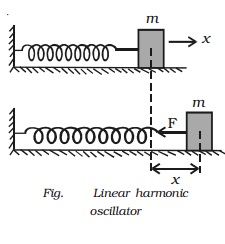
Restoring force F = −kx
From Newton?s second law, we know that F
= ma
∴ ma = −kx
A =
−kx / m
Comparing with the equation of SHM a =
−ω2x, we get
ω2 = k/m
ω = rt( k/m )
But T = 2π / ω
Time period T = 2π rt(m/k)
∴ Frequency n =
1/T = 1/2 π rt( k/m )
Vertical oscillations of a spring
Fig a shows a light,
elastic spiral spring suspended vertically from a rigid support in a relaxed
position. When a mass ?m? is attached
to the spring as in Fig. b, the spring is extended by a small length dl such
that the upward force F exerted by
the spring is equal to the weight mg.
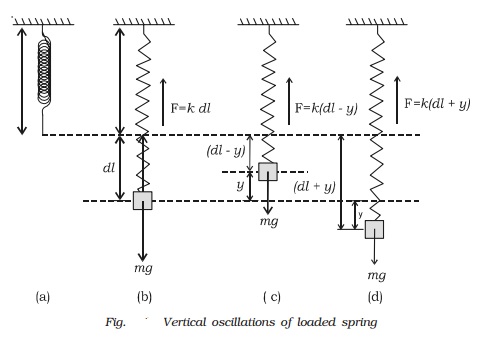
The restoring force F = k dl
; k dl = mg ...(1)
where k
is spring constant. If we further extend the given spring by a small distance
by applying a small force by our finger, the spring oscillates up and down
about its mean position. Now suppose the body is at a distance y above the
equilibrium position as in Fig. c. The extension of the spring is (dl − y). The upward force exerted on the body is k (dl − y) and the resultant force
F on the body is
F
= k (dl - y) - mg = -ky ???..(2)
The resultant force is
proportional to the displacement of the body from its equilibrium position and
the motion is simple harmonic.
If the total extension produced is (dl + y)
as in Fig. d the restoring force on the body is k (dl + y) which acts upwards.
So, the increase in the upward force on the
spring is
k
(dl + y) −mg
= ky
Therefore if we
produce an extension downward then the restoring force in the spring increases
by ky in the upward direction. As the
force acts in the opposite direction to that of displacement, the restoring
force is − ky and the motion is
SHM.
F
= - ky
ma = - ky
a = − k/m y ?(3)
a = −ω2
y (expression for SHM)
Comparing the
above equations, ω = rt(k/m)
But T = 2π / ω =
2π rt(m/k)
From equation
(1) mg = k dl
m/k = dl/g
Therefore time
period T = 2π rt(dl/g) ??(6)
Frequency n =
1/2 π rt(g/dl)
Case 1 : When two springs are connected in parallel
Two springs of
spring factors k1 and k2 are suspended from a rigid support as shown in Fig. A
load m is attached to the combination.
Let the load be
pulled downwards through a distance y from its equilibrium position. The
increase in length is y for both the springs but their restoring forces are
different.
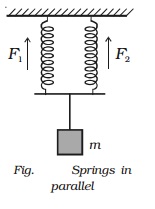
If F1
and F2 are the restoring forces
F1 = −k1y,
F2 = −k2y
∴
Total restoring force = (F1 + F2) = −(k1 + k2)
y
So, time period of the body is given by
T = 2π rt(m / k
+k)
If k1 = k2 = k
Then, T = 2π
rt(m/ 2k)
∴
frequency n = 1/2 π . rt(2k/m)
Case 2 : When two springs are connected in series.
Two springs are connected in series in two
different ways. This arrangement is shown in Fig. a and b.
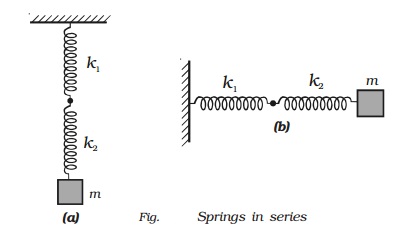
In this system
when the combination of two springs is displaced to a distance y, it produces
extension y1 and y2 in two springs of force constants k1
and k2.
F = −k1
y1 ;
F = −k2
y2
where F is the
restoring force.
Total extension,
y = y1 + y2 = −F [1/k1 + 1/k2]
We know that F =
−ky
y= - F/k
From the above
equations,
-F/k = −F [1/k1 + 1/k2]
Time period = T
= 2π . rt(m(k1+k2)/k1k2)
frequency n =
1/2 π . rt(k1k2 / m(k1+k2) )
If both the
springs have the same spring constant,
k1 = k2 = k
n= 1/2 π .
rt(k/2m)
Related Topics